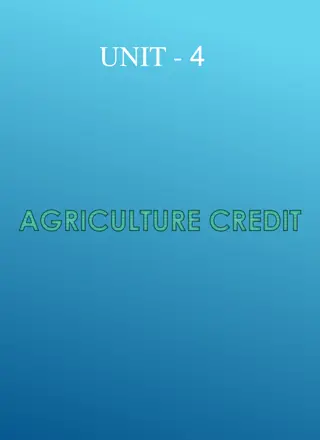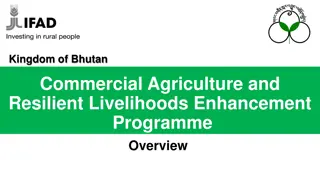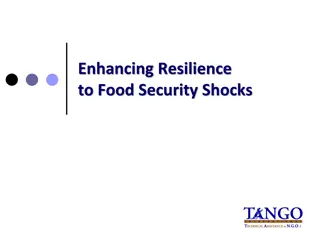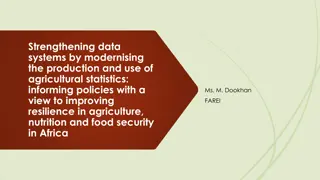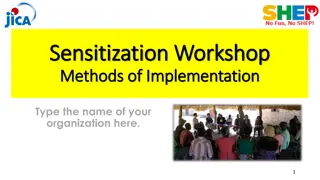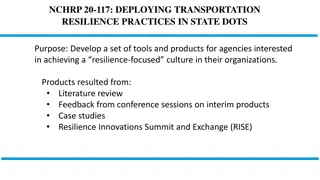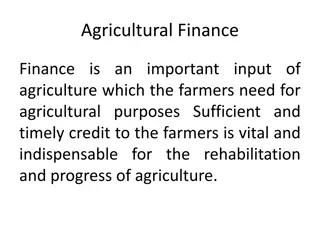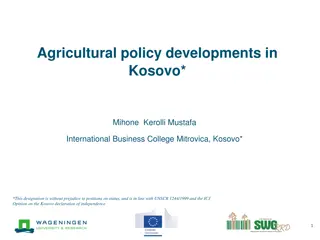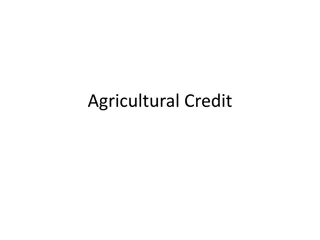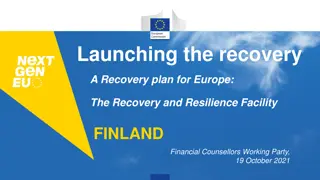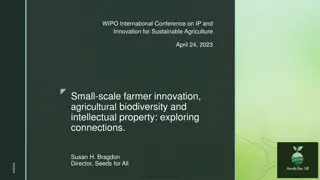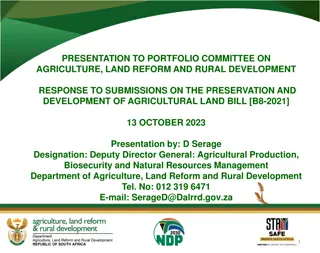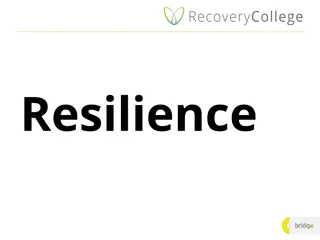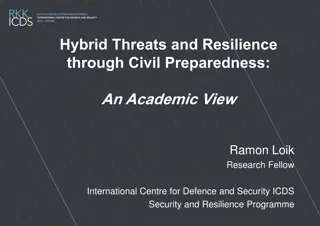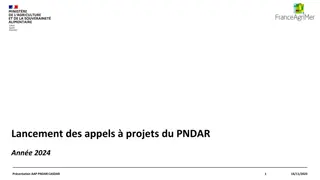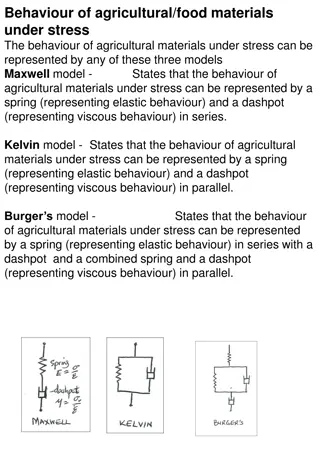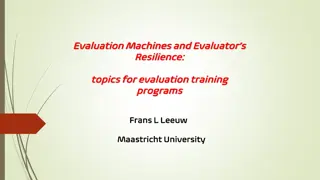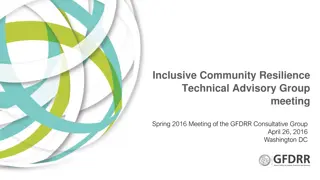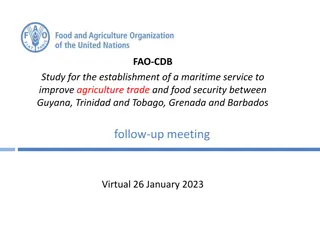Understanding the RIMA-II Model for Resilience Measurement in Agricultural Development
The RIMA-II model offers an innovative quantitative approach to measuring resilience in the context of food insecurity. It provides a framework for understanding how households cope with shocks and stressors, enabling effective assistance for vulnerable populations to build food secure and resilient livelihoods. The operationalization of FSINs adaptive, transformative, and absorptive capacities through resilience pillars like adaptive capacity, social safety nets, access to basic services, and assets plays a crucial role in enhancing resilience in communities, particularly in regions like Juba, South Sudan.
Download Presentation

Please find below an Image/Link to download the presentation.
The content on the website is provided AS IS for your information and personal use only. It may not be sold, licensed, or shared on other websites without obtaining consent from the author. Download presentation by click this link. If you encounter any issues during the download, it is possible that the publisher has removed the file from their server.
E N D
Presentation Transcript
Resilience Index Measurement and analysis Model-II RIMA-II Resilience Exchange Network Venue: NGO Forum Date27thMarch 2018 Owen Calvert Project Manager SUSTAINABLE AGRICULTURE FOR ECONOMIC RESILIENCY Juba, South Sudan Food and Agriculture Organization of the United Nations
The RIMA-II model Resilience measurement at FAO
The RIMA model RIMA Analysis) is an innovative quantitative approach that estimates resilience to food insecurity and generates the evidence for more effectively assisting vulnerable populations. (Resilience Index Measurement and RIMA allows explaining why and how some households cope with shocks and stressor better than others do and provides rigorous framework for humanitarian development initiatives to build food secure and resilient livelihoods. and long-term
RIMA perfectly suits several definitions of resilience: Defining resilience The ability to prevent disasters and crises as well as to anticipate, absorb, accommodate or recover from them in a timely, efficient and sustainable manner (FAO, 2013) The capacity of a household to bounce back to a previous level of well-being (for instance food security) after a shock (Alinovi, Mane & Romano, 2009) The capacity that ensures adverse stressors and shocks do not have long-lasting consequences (Resilience Working Group of the Food Security Information Network, 2014) adverse Measurement development Technical
Operationalization of FSINs Adaptive, Transformative and Absorptive capacities Resilience pillars Household resilience Social safety nets (SSN) Access to basic services (ABS) Assets (AST) Adaptive capacity (AC)
Resilience pillars Definition Resilience pillars Adaptive Capacity is the ability of a household to adapt to a new situation and develop new strategies of livelihood Adaptive Capacity The Social Safety Nets pillar measures the ability of households to access timely and reliable assistance provided by international agencies, charities, and NGOs, as well as help from relatives and friends. Social Safety Nets Assets comprise both productive and non-productive assets. Examples of indicators include land, livestock and durables. Other tangible assets such as house, vehicle, and household amenities reflect living standards and wealth of a household. Access to Basic Services shows the ability of a household to meet basic needs, and access and effective use of basic services; e.g., access to schools, health facilities; infrastructures and markets. Assets Access to Basic Services
The procedure RCI estimation
RESILIENCE ANALYSIS WESTERN EQUATORIA FOOD CONSUMPTION SCORE FCS FCS Poor Borderline Acceptable Total Percent 70 23 7 100 Food Consumption Score FCS Desegregated by county 7% 23% Border line County Poor Acceptable Total 70% 63.8 68.8 78.5 70.3 26.3 27.3 15.2 22.9 10.0 3.9 6.3 6.8 100 100 100 100 Tambura Nzara Yambio Overall Poor Borderline Acceptable
RESILIENCE ANALYSIS FOOD GROUPS CONSUMPTION PER WEEK Variable CEREALS PULSES MILK MEAT VEG FRUIT SUGAR FISH Obs Mean Std. Dev. Min Max 236 236 236 236 236 236 236 236 2.13 1.74 0.78 1.05 1.97 0.86 1.32 0.28 0 0 0 0 0 0 0 0 7 7 7 7 7 7 7 2 3.86 0.91 0.17 0.62 2.87 0.34 0.55 0.08 Food Groups Consumption per week fg_cereals~s 4.00 3.00 fish fg_pulses 2.00 1.00 fg_sugar fg_milk 0.00 fg_fruit fg_meat fg_veg
RESILIENCE ANALYSIS WATER QUALITY Source of drinking water Untreated water source/River Water from deep borehole fitted with a hand pump Tap water Surface water (run off, etc) Other(Rain water collected, Bottled water, treated tanker) Total % 44 24 9 20 Source of drinking water 2% 20% 3 100 45% 9% 24% Untreated water source/River Water from deep borehole fitted with a hand pump Tap water Surface water (run off, etc) Other(Rain water collected, Bottled water, treated tanker)
RESILIENCE ANALYSIS WATER TIME It takes approximately an hour for a household member to fetch water from the main source. Variable Time taken to and from main water source Obs Mean Std. Dev. Min Max 236 52.52 49.78 0.6 345
RESILIENCE ANALYSIS SHOCKS SHOCKS Reduce Employment Reduced Income Illness/accident of key hh member Death of key hh member High food prices High fuel/transport prices Drought Pest and disease Violent insecurity Epidemics PROPORTION 0.02 0.09 0.28 0.21 0.44 0.19 0.06 0.07 0.45 0.03 SHOCKS 0.45 0.50 0.44 0.45 0.40 0.35 0.28 0.30 0.21 0.25 0.19 0.20 0.15 0.09 0.07 0.06 0.10 0.03 0.02 0.05 0.00
RESILIENCE ANALYSIS RCI AND PILLARS Pillars correlation, Yambio cluster 2017 ABS AC AST .25 .5 SSN correl_abs Source: Author's own calculation
RESILIENCE ANALYSIS RCI AND PILLARS
RESILIENCE ANALYSIS RCI AND PILLARS
RESILIENCE ANALYSIS RCI AND PILLARS
RESILIENCE ANALYSIS MALE VS. FEMALE RESILIENCE CAPACITY Resilience capacity: Average resilience index by county in Yambio Cluster 30 Resilience Capacity mean 20 10 0 yambio nzara tambura
RESILIENCE ANALYSIS AVERAGE RESILIENCE INDEX Female Headed HH RCI 26.56 FCS 17.11 HDDS 3.385 Improved water 0.0923 Distwater 5.342 Productive ast 0.272 Householdast 0.797 Landsize 1.738 TLU 0.0245 Accesscredit Borrow 0.0923 Accesscredit borrow freq 0.0308 Accesscredit Assistance 0.0615 Hhhedu 3.092 Hhfedu 3.8 Male Headed HH 29.4 18.72 3.784 0.117 3.534 0.235 0.986 1.842 0.0426 Resilience capacity: Average resilience index by gender in Yambio Cluster 30 Resilience Capacity mean 20 0.0936 0.0585 10 0.0468 5.491 2.246 2.523 1.031 6.298 1.234 Hhmedu Income 0 Female Male









